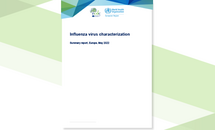Influenza virus characterisation - Summary Europe, February 2022
This is the fourth report for the 2021−2022 influenza season. As of week 08/2022, 44 665 influenza detections across the WHO European Region were reported to TESSy, an increase of over 41 000 since week 47/2021 with most being reported from week 49/2021 onwards.
Executive Summary
Of these 44 665 detections, 97% were type A viruses, with A(H3N2) (93%) dominating over A(H1N1)pdm09 (7%), and 3% type B, with only 19 having been ascribed to a lineage, all of which were B/Victoria. This represents a large increase (43 953, 6273%) in detections compared to the 2020−2021 season, on the back of a large increase (1 274 874, 383%) in the number of samples tested. However, while there have been clear indications of an influenza epidemic in 2021−2022, with the epidemic threshold of 10% positivity within sentinel specimens having been crossed for a number of weeks (unlike 2020−2021), detection numbers are significantly reduced compared to earlier seasons (e.g. 65% reduced compared to 2019−2020). The increased testing but reduced number of influenza detections is undoubtedly related to the emergence of SARS-CoV-2 and measures introduced to combat it.
Since the December 2021 characterisation report1, 17 shipments from EU/EEA countries have been received at the London World Health Organization (WHO) Collaborating Centre, the Francis Crick Worldwide Influenza Centre (WIC) and many of the samples in these shipments have yet to be fully characterised. This report therefore focuses on viruses with collection dates after 31 August 2021 for which HA gene sequences were available in GISAID as of 8 February 2022, together with sequences generated and antigenic data determined at the WIC.
On a global scale, relatively few A(H1N1)pdm09 viruses have been detected in the course of the 2021−2022 season. The subgroups 6B.1A.5a.1 and 6B.1A.5a.2 are equally represented, with subgroup dominance varying between countries. The subgroups are antigenically different and while 6B.1A.5a.1 viruses have been most widespread in Europe, an emergent genetic group within this subgroup has been detected, defined by HA1 P137S and G155E amino acid substitutions and showing antigenic drift. At the February 2022 WHO influenza vaccine composition meeting (VCM) the recommendation was to retain A/Victoria/2570/2019-like viruses (6B.1A.5a.2) as the vaccine component for the northern hemisphere 2022−2023 influenza season.
In Europe and across the world A(H3N2) viruses have been dominant with the vast majority of recently detected viruses falling in subgroup 3C.2a1b.2a being ‘Bangladesh-like’. While small clusters of viruses showing antigenic drift have emerged within this subgroup, the vast majority of viruses retained good recognition by post-infection ferret antisera raised against A/Darwin/9/2021-like and A/Darwin/6/2021-like (3C.2a1b.2a.2) viruses, which were recommended for egg- and cell-based vaccines to be used in the 2022 southern hemisphere season. At the February 2022 WHO VCM the recommendation was to change the A(H3N2) vaccine component for the northern hemisphere 2022−2023 influenza season to match those to be used in the 2022 southern hemisphere season.
In Europe and across the world, few B/Victoria-lineage viruses have been detected during the 2021−2022 influenza season. All have lost encoding of a three amino acid triplet (HA1 residues 162-164) placing them in subclade V.1A.3 represented by B/Washington/02/2019, the vaccine virus recommended for inclusion in influenza vaccines for the 2021−2022 northern hemisphere season. The majority of HA sequences from recently detected viruses in geographically dispersed countries have fallen in the V1A.3a group, defined by a series of HA1 amino acid substitutions including N150K. Most of these fall within the V1A.3a.2 subgroup with defining HA1 A127T, P144L and K203R amino acid substitutions. Viruses in subgroup V1A.3a.2 are not recognised well by post-infection ferret antisera raised against B/Washington/02/2019-like viruses and B/Austria/1359417/2021-like (V.1A.3a.2) viruses were recommended for use in the southern hemisphere 2022 influenza season. At the February 2022 WHO VCM, the recommendation was to change the B/Victoria-lineage vaccine component for the northern hemisphere 2022−2023 influenza season to match those to be used in the 2022 southern hemisphere season.
No cases of infection with circulating B/Yamagata-lineage viruses have been confirmed since March of 2020. All HA gene sequences from the 77 viruses detected in 2020, inclusive of 12 from EU/EEA countries, belong to genetic clade 3 (Y3) and carry three HA1 amino acid substitutions (L172Q, D229N and M251V) compared to B/Phuket/3073/2013-like viruses which are still recommended for use in quadrivalent influenza vaccines. The antigenic effects of these amino acid substitutions have been minimal, as assessed in earlier reports.
Download







